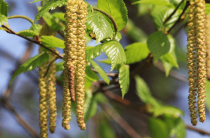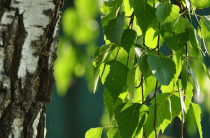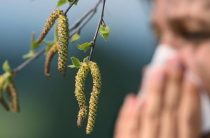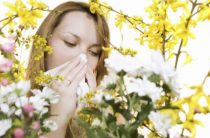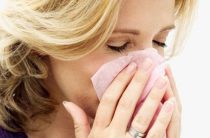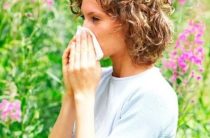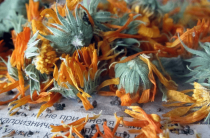Pollen allergy is a disease that every tenth inhabitant of the earth faces in our world. Moreover, judging by the rate of increase in the incidence, this is only the beginning. The originality of this disease is such that this issue is one of the most pressing not only in the field of allergology, but also in medicine in general.
Why does pollen allergy occur?
In our body there are special proteins that serve as part of the immune system. In pollen allergy, these substances are susceptible to the components contained in plant pollen. They are found in significant concentrations in the tissues of the mucous membranes (eyes, nose, larynx, lungs), which most often encounter these allergens and are very vulnerable to their action.
Pollen is a very insidious substance. It has microscopic dimensions, thanks to which it easily seeps through the cells of the mucous membranes. In addition, this substance is extremely abundant in the surrounding air. Plants are pollinated by wind transfer. Therefore, the slightest breath of it is enough for the pollen to scatter many hundreds of meters. For this reason, it is very difficult for an allergic person to protect himself from the action of potential sources of allergy during the flowering of a plant unfriendly to him.
There are a little over fifty plants whose pollen has allergenic properties for a vulnerable person. Pollen allergy has a strong seasonal relationship. The flowering of any plant occurs in an unequal period, the onset of which is determined by a number of factors. The leading role is played by the climatic zone of its growth.
With an allergy to flowering, several bursts of activity differ:
| April May | at this time there is a flowering of trees (alder, oak, ide, maple, poplar, aspen) |
| June July | the color of herbs begins (timothy, wheatgrass, rye, fescue, dandelion, ryegrass, etc.) |
| August - October | the allergenic period ends with the flowering of weeds, which lasts from the end of summer and ends in mid-autumn |
There can be several weeks of difference between the specific time intervals during which a certain plant blooms. This is determined by the specific area in which the pollination of plants occurs. Therefore, people who suffer from pollen allergies need to familiarize themselves with the specific timing of flowering plants. Incidents when plant pollen excites allergies, regardless of which plant it belongs to, are practically not observed. Often, the patient feels allergy symptoms only after contact with this plant.
Pollen Allergy Symptoms
For the most part, it is the organs of the respiratory system, as well as the eyes, that are involved in the onset of the symptoms of the disease.
| Symptom Name | Its manifestations |
| allergic rhinitis |
|
| Allergic conjunctivitis |
|
| allergic asthma |
|
In addition to specific symptoms, during a pollen allergy, patients often experience general malaise, weakness, fever, and headache. Often, these symptoms are the first signs of an impending disease. As for the symptoms themselves, the involvement of only one organ in the clinical picture of the disease is a phenomenon that is the exception rather than the rule. Basically, the course of the disease is characterized by the involvement of the entire respiratory system in allergic symptoms, as well as a violation of the general well-being of the patient.
Pollen Allergy Diagnosis
An allergist or immunologist deals with the diagnosis of the disease. The diagnosis is made on the basis of the data that the doctor receives from the patient during the interview, as well as the results of special diagnostic measures.
Diagnostic algorithm:
step number 1 - establishing a causal relationship between the flowering of a plant and the manifestation of symptoms. For this, a special flowering calendar is used, which indicates the flowering period of certain plants characteristic of the area. This step is necessary in order to narrow down the hypothetical range of allergenic plants.
step number 2 - the doctor must necessarily familiarize himself with the family history of the disease. Of great importance is the presence of an allergic disease in close relatives of the patient. This is due to the fact that allergy is a disease with a possible hereditary nature, and the presence of a family history of allergic disorders can serve as an indirect argument in making a diagnosis.
step number 3 - conducting special analyzes. There are a number of diagnostic measures that can confirm the diagnosis, as well as find out the basis for the occurrence of allergies by finding the allergen that causes it.
Skin tests
In pollen allergy, skin diagnostics is the most accurate diagnostic method, which, in addition to the presence of the allergic nature of the disease, also makes it possible to determine the allergen of a particular plant that triggers the symptoms of the disease. Skin tests can be performed in various ways: by applying a special dressing soaked in allergen solutions, using scalpel incisions or injections with a syringe. The specific method is chosen depending on the state of health of the patient, but in any case, the essence is the same. The reaction of the skin upon contact with pollen solutions is of diagnostic importance.
Before conducting skin tests, it is necessary to narrow the range of suspected allergens, based on the patient's complaints. This is because skin tests are limited and cannot cover all allergens in this disorder. It is contraindicated to carry out skin tests if the patient has an active phase of allergic reactions. In this case, the intake of an additional amount of the allergen can lead to a significant aggravation of the symptoms. Also, contraindications in relation to skin tests are pregnancy, early childhood, age over 60 years and the presence of infectious diseases.
Provocative Tests
One of the most revealing diagnostic measures for pollen allergy is provocative tests. Due to their visualization, they have the highest degree of reliability, demonstrating not only the presence of allergic reactions and susceptibility to specific allergens, but also the appearance of symptoms, as well as the relationship between the amount of the ingested substance and the severity of manifestations.
Depending on the indications, a special test liquid is injected through the nose, instilled into the eyes or using a special inhalation. For diagnostics, a minimum concentration is used, which then gradually increases as needed. The need to increase the dosage of the test solution may be due to the high degree of validity of the assumption about the allergenicity of this substance for a particular patient. After the implementation of a provocative diagnosis, special means are used that relieve the symptoms that have arisen during a positive reaction to plant pollen.
Blood test for pollen allergy
An allergic reaction begins as a result of the characteristics of the patient's immune system, which contribute to the production of special antibodies. Actually antibodies are responsible for recognizing a substance as an allergen, and also trigger the mechanism of an allergic reaction. With allergies, the level of general and special antibodies increases.
If an increase in total antibodies is recorded, in addition to allergic reactions, this may be a confirmation of the presence of a parasitic infection. While the presence of special bodies is a direct confirmation that the patient is allergic to the pollen of a particular plant. For this diagnostic method, venous blood is taken from the patient. After this procedure, the blood material is subjected to contact with all kinds of allergens, which are isolated from plant pollen.
Also, if you are allergic to pollen, a general blood test is taken. This is an important measure that allows you to track your overall health. But besides this, in the blood formula during allergic reactions, you can notice the presence of specific components. We are talking about eosinophils - cells that form antibodies. During an allergic reaction, the presence of eosinophils in the blood steadily increases. Diagnosis of the level of eosinophils is also an important characteristic for establishing an allergy to pollen.
Pollen Allergy Treatment
During the treatment of pollen allergy, a variety of methods and directions are used in order to effectively influence the manifestation of the disease. The use of an integrated approach allows for extremely effective treatment with a minimum of side effects.
Treatment for pollen allergy includes:
- the use of special methods aimed at reducing the duration and frequency of contact with the allergen;
- pharmacological influence on the manifestations of the disease;
- decrease in sensitivity to an allergen with the help of immunotherapy.
Medical treatment
To date, it is impossible to name a drug that could be used to combat pollen allergy as a single therapy. For this reason, for each individual patient, depending on the manifestations of the disease and other clinically significant characteristics, specialized treatment is selected. It includes: antihistamines, glucocorticoids, vasoconstrictors.
- Antihistamines
This group of drugs is used to suppress the effect of this biologically active compound on susceptible cells. To understand the mechanisms of action of these drugs and their effectiveness, it is necessary to briefly familiarize yourself with the role of histamine in our body and how it is associated with pollen allergy. Histamine is a biologically active compound that is released under the influence of antibodies. It is under its influence that the manifestations of allergies are formed. The use of antihistamines allows you to save yourself from various manifestations of pollen allergy: sneezing, runny nose, tearing, allergic cough, etc.
The first antihistamines (tavegil, demidrol, suprastin, diazolin, etc.) are drugs with a significant risk of side effects. If used correctly, their effectiveness in relation to allergy symptoms is very high. Unfortunately, they have a very annoying side effect, which is caused by the effect on the nervous system. It consists in stimulating the processes of inhibition, which the patient experiences as bouts of daytime weakness, drowsiness, and a decrease in the potential of intellectual activity. This forces them to increasingly abandon their use in favor of more modern antihistamines (claritin, zyrtec, ebastine, erius, etc.)
In addition, antihistamines in the form of drops and nasal sprays can also be used. This is highly relevant in pollen allergies, in which these organs are primarily involved.
- Corticosteroid drugs
Corticosteroid drugs are hormonal drugs that are used to suppress inflammatory and allergic reactions. Their influence on allergy symptoms is extremely powerful and effective. The problem with their use is the significant risk of side effects. Therefore, they are prescribed courses of minimum duration. They are used either in the form of injections (in case of an extremely acute manifestation of allergies), or in the form of drops and sprays, which is more typical for the treatment of the vast majority of cases of pollen allergy.
- Vasoconstrictor drugs
Vasodilation of the eyes and nose is one of the main symptoms that a patient experiences with pollen allergy. The expansion of the local capillaries of the nose makes breathing much more difficult, and sometimes even makes it impossible with the help of the nose, while the expansion of the eye capillaries causes irritation, pain in the eyes and fatigue. In order to smooth these symptoms, the doctor may, in individual episodes, prescribe special vasoconstrictors. They are not used for more than 4 days, so as not to provoke drug dependence. In the future, after the removal of acute symptoms, these symptoms are treated with the help of safer methods of therapy.
- Mast cell membrane stabilizers
The provided group of drugs is one of the most harmless medicines for the treatment of allergies. Their action prevents the release of histamine and other substances involved in the formation of allergy symptoms by immune cells. However, the currently available drugs in this group are more suitable as a tool for prevention than for the direct elimination of already existing symptoms. If you are allergic to pollen, start a course of therapy with this drug a few months before it starts.
Methods of immunotherapy
With pollen allergy, the method of immunotherapy has proven itself very well. At the moment, with this disease, it turns out to be one of the most effective. This technique is getting better every year. Its effectiveness lies in the fact that it directly affects the patient's immunity, as a result of which the body for some time loses its susceptibility to the components of plant pollen.
To begin with, during laboratory diagnostics, a specific allergen is proved that causes the symptoms of the disease. After that, in a medical hospital, a special solution is made, which contains the minimum allowable dosage. During the injection session with a solution of allergens, its concentration increases gradually. This gives the body the potential to adapt to the allergen and lose sensitivity to it for a certain amount of time.
In case of pollen allergy, the start of immunotherapy is implemented at the end of autumn, when the allergenic plants have faded. As a result, due to long sessions, the patient can approach the beginning of flowering of the allergen plant with a leveled immune sensitivity.
Pollen Allergy and Prevention
To prevent pollen allergies, take the following steps:
- Walking in the morning and afternoon, in dry weather, should be stopped. At this time, the air is simply teeming with allergens. It is also worth protecting yourself from the wind, which can carry pollen that was many kilometers away;
- Equip windows with special nets that have a minimum diameter of holes;
- Do wet cleaning as often as possible;
- After coming from the street, rinse your head thoroughly, wash exposed skin with soap and remove clothes;
- Use special respirators and goggles when you are outside;
- Get rid of heavy fabric curtains, as well as soft toys - they absorb what has fallen from the street;
- Use special indoor air purifiers.
Pollen allergy is successfully preventable. Although some of its measures may seem burdensome, their use allows you to avoid or at least reduce the undesirable manifestations of this disease.
